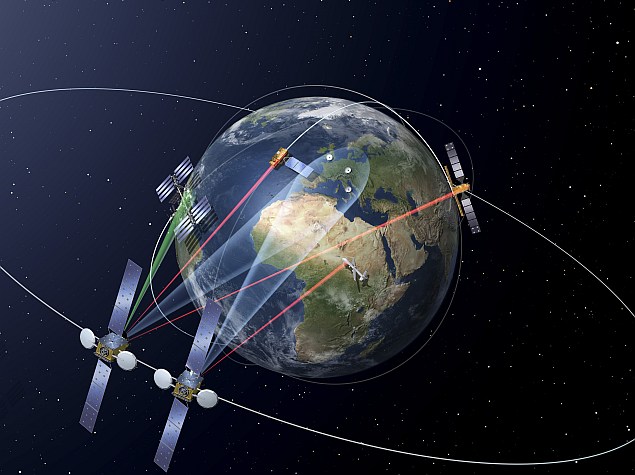- Home
- Internet
- Internet News
- Europe's Space Based, Laser Powered Data Highway Passes Early Test
Europe's Space-Based, Laser-Powered Data Highway Passes Early Test

The images were a test of a 450 million euro ($562 million, roughly Rs. 3,500 crores) space data highway being constructed. Called European Data Relay Satellite (EDRS), it will allow faster and more secure transmission of large amounts of data, such as pictures and radar images, to and from earth.
It is seen as particularly useful for monitoring flood and earthquake damage in real time.
"Currently, a satellite downloads the data that it acquires whenever it is within view of one of four ground stations on earth," Josef Aschbacher, head of the European Space Agency's (ESA) Earth Observation Programme Planning & Coordination Service, told Reuters ahead of Friday's transmission.
"That means there can be periods of 45 to 90 minutes from the visibility of one station to another," he said.
Once completed, EDRS will do away with such blind spots by using two satellites - to be launched in 2015 and 2016 and equipped with laser technology - to send data to and from Earth or between satellites at a rate of 1.8 Gigabits per second.
That is about equivalent to sending all the data that could be printed in a one-metre long shelf of books in one second, according to generally accepted industry measures.
EDRS will also offer encryption for more secure transmissions, and will make Europe less dependent on ground stations abroad to access satellite data.
In Friday's transmission, a satellite launched as part of Europe's Copernicus project in April, Sentinel-1a, sent images across a distance of 36,000 kms (22,369 miles) to Inmarsat's communications satellite Alphasat, which relayed the signal to earth.
The demonstration of the new technology is key to getting the European Commission's go-ahead for the space agency to sign an agreement making Airbus unit Astrium the operator of EDRS ahead of a December 22 deadline.
EDRS will later relay data on sea ice, oil spills or floods from the multi-billion euro Copernicus earth observation project, but its services will also be available to other paying customers.
© Thomson Reuters 2014
Get your daily dose of tech news, reviews, and insights, in under 80 characters on Gadgets 360 Turbo. Connect with fellow tech lovers on our Forum. Follow us on X, Facebook, WhatsApp, Threads and Google News for instant updates. Catch all the action on our YouTube channel.
Related Stories
- Samsung Galaxy Unpacked 2025
- ChatGPT
- Redmi Note 14 Pro+
- iPhone 16
- Apple Vision Pro
- Oneplus 12
- OnePlus Nord CE 3 Lite 5G
- iPhone 13
- Xiaomi 14 Pro
- Oppo Find N3
- Tecno Spark Go (2023)
- Realme V30
- Best Phones Under 25000
- Samsung Galaxy S24 Series
- Cryptocurrency
- iQoo 12
- Samsung Galaxy S24 Ultra
- Giottus
- Samsung Galaxy Z Flip 5
- Apple 'Scary Fast'
- Housefull 5
- GoPro Hero 12 Black Review
- Invincible Season 2
- JioGlass
- HD Ready TV
- Laptop Under 50000
- Smartwatch Under 10000
- Latest Mobile Phones
- Compare Phones
- Redmi Note 15 5G
- Redmi Note 15 Pro 5G
- Redmi Note 15 Pro+ 5G
- Lava Play Max
- Poco C85 5G
- Honor Magic 8 Lite
- Jolla Phone
- Realme P4x 5G
- Asus ProArt P16
- MacBook Pro 14-inch (M5, 2025)
- OnePlus Pad Go 2
- Poco Pad M1
- Just Corseca Skywatch Pro
- Honor Watch X5
- Acerpure Nitro Z Series 100-inch QLED TV
- Samsung 43 Inch LED Ultra HD (4K) Smart TV (UA43UE81AFULXL)
- Asus ROG Ally
- Nintendo Switch Lite
- Haier 1.6 Ton 5 Star Inverter Split AC (HSU19G-MZAID5BN-INV)
- Haier 1.6 Ton 5 Star Inverter Split AC (HSU19G-MZAIM5BN-INV)

















